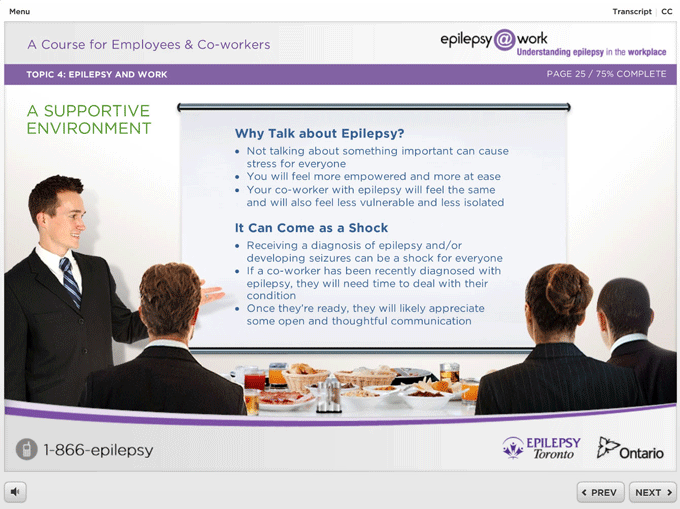TORONTO – National statistics on epilepsy suggest that about 0.6 per cent of the population has the condition. About 15,500 people per year are diagnosed – they could be your family, friends and coworkers.

But do you understand the mechanics behind epilepsy? Canadian experts created a new toolkit to shed light on the disorder for employers, human resources managers and colleagues. Their hope is their tools will remove the stigma behind a disorder that’s easily manageable.
On Monday, Epilepsy Toronto launched its Epilepsy at Work toolkit, a resource that walks its users through the spectrum of epilepsy from diagnosis to receiving treatment and accommodation in the workplace.
Woodley suggests it’s timely. A 2012 survey found that just over 50 per cent of adults aged 18 to 64 with epilepsy are working. Of those who were out of a job, 30 per cent couldn’t find steady employment.
The national unemployment rate hovers at about seven per cent, Woodley says. Those with epilepsy have a four-fold increase.
READ MORE: Global’s Inside Epilepsy series
It may be because employers don’t know about how easy it is to create comfortable, productive work environments for people with the condition.
They’re basic adjustments: keep the work day to a schedule so your employee can take his or her medications on time, don’t let stress levels skyrocket, and have a quiet space in the office so employees can decompress when needed.
“People with epilepsy have lower rates of absenteeism and higher productivity because they’re personally taking it upon themselves to work harder to make up for a perceived disability,” Woodley explained.
Epilepsy at Work is the result of two years of work. Various employers, HR managers and members of the epilepsy community collaborated with storytellers, videographers and developers to create the toolkit.
The Ontario government poured funding into the program’s development, too.
The information is doled out in interviews, videos and quizzes. It’s meant to be engaging and interactive, Woodley says.
READ MORE: Toronto woman’s crusade to shed light on treatment options

It even helps staff understand practical knowledge, such as how to respond if a coworker is experiencing a seizure.
Woodley says the organization is hoping the program will come to use if HR managers and bosses learn that an employee has been diagnosed with epilepsy, for example.
“We thought there’s a real need to provide resources to employers and employees on how to set up proper accommodation in the workplace,” Woodley said.
Take a look at the toolkit here.
Epilepsy is the third most common neurological disorder in adults after stroke and Alzheimer’s disease, according to the University Health Network.
Each day, about 42 people are diagnosed with the condition, according to the organization. That’s about 15,500 people a year, on average.
But the numbers could be higher.
READ MORE: Inside Epilepsy – Answering a call to action
“Due to stigma surrounding epilepsy and the prejudice with which society has historically treated people with epilepsy, many with the disorder are reluctant to admit it or to seek treatment,” the website says.
About 44 per cent are diagnosed before the age of five, but half of these cases dissipate completely. It’s the most common neurological disorder in children.
Epilepsy is a physical condition marked by sudden, brief changes in the brain’s function.
The unusual activity in the brain causes patients to have recurring, unprovoked seizures, according to Dr. Danielle Andrade, director of genetics at the Krembil Neuroscience Centre’s epilepsy program.
There is a wide spectrum when identifying a seizure, from convulsions on one end to tuning out for just a few seconds before returning to regular activities.
“A seizure is an abnormal electrical discharge in the brain. So some part of the entire brain starts firing up very quickly and this may cause symptoms depending on what part of the brain is firing abnormally,” she told Global News.
For instance, if a seizure triggers the part of your brain that controls vision, you could have problems with vision during the episode. If the seizure affects the part of your brain that deals with speech, you’d have speech difficulties, Andrade explains.
If both sides of the brain fire up simultaneously, patients could experience a convulsion – a medical condition in which the body’s muscles contract and relax quickly causing uncontrolled shaking.
Andrade says some people note the onset of a seizure. They feel “something strange,” whether it’s a sensation in their stomachs or a feeling in their heads.
Sometimes they’re still conscious as it’s happening. “But as the abnormal firing continues and spreads to adjacent brain regions that may cause more symptoms,” she said.
At that point, consciousness may be lost.
Click here to get involved with Epilepsy Toronto.
carmen.chai@globalnews.ca
Follow @Carmen_Chai




Comments